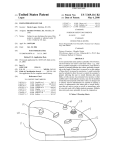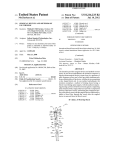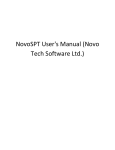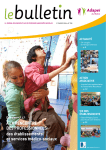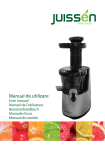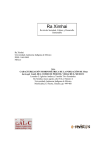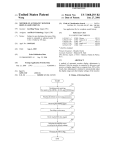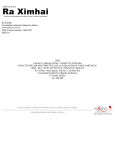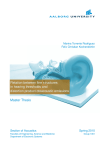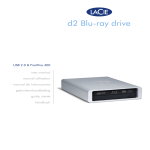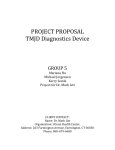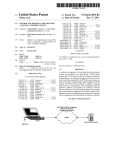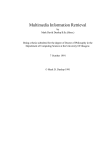Download Foot-operated key pad
Transcript
US007554526B2 (12) Ulllted States Patent (10) Patent N0.: Logue US 7,554,526 B2 (45) Date of Patent: (54) FOOT-OPERATED KEY PAD (75) Inventor: Jun. 30, 2009 (Continued) Rebecca L. Logue, Meridian, ID (U S) _ _ _ FOREIGN PATENT DOCUMENTS JP 09-114583 5/1997 (73) Ass1gnee: Beckmer Products, Inc., Meridian, ID (US) (*) Notice: (Continued) Subject to any disclaimer, the term of this Pawnt is extended or adjusted under 35 OTHER PUBLICATIONS Kinesis Programmable Foot Switch (PS/2 Version) User’s Manual, U.S.C. 154(b) by 0 days. Aug. 2000 Edition. (21) Appl. No.: 12/116,182 . (Continued) _ Primary ExamineriRicardo L Osorio (22) Flled' May 6’ 2008 (65) (74) Attorney, Agent, or FirmiPedersen & CO., PLLC; Ken Prior Publication Data US 2008/0284725 A1 J. Pedersen; Barbara S. Pedersen Nov. 20, 2008 (57) Related US. Application Data ABSTRACT A foot operated data entry pad has a plurality of foot-operated (63) Continuation-in-part of application No. 10/973,999, ?led on Oct. 25, 2004, noW Pat. No. 7,369,116. (60) Provisional application No. 60/513,929, ?led on Oct. 23, 2003. (51) Int- Cl- buttons’ The foot buttons are used 10 enter (.iata. valuesie'g" numbers or symbols separately or in combination. Each but . . . ton is capable of entering different data values, preferably depending on the length of time that it is pressed or on the number of times that it is pressed in succession. A small controller may be included to alloW the user to control the (52) (58) computer’s pointer, allowing the user to sWitch betWeen data G06F 3/033 (2006-01) entry ?elds, as With a mouse. A heel rest may serve as both a G09G 5/08 (2006-01) heel rest and a button/switch for sending an electric/ electronic US. Cl. ..................................... .. 345/163; 345/156 Field of Classi?cation Search ........ .. 345/1 5641 68 signal. An automated voice system, or other audible and/or visual indicator system, may also be included to help the user See application ?le for complete Search history, _ (56) References Clted alphanumeric data rather than a simple binary-type data set, us PATENT DOCUMENTS 3 943 914 A 3/l976 G f 11 t al , , ren e e . . . . . . 128/2 S . . . .. 4,446,453 A 5/1984 Eenboom et al. . 340/286 M 4,904,184 2/1990 . . . . . .. 433/72 A 4,922,925 A keep track of the data value as it changes and is entered. Various embodiments are capable of entering a variety of Murphy et al. ...... 5/1990 Crandall et a1. ........... .. 600/595 such as yes/no or on/off, or instructions, such as a joystick used With a ?ight simulator program. Multiple data entry pads - - - - may Opnonany be used “1 conluncnon' 22 Claims, 9 Drawing Sheets US 7,554,526 B2 Page2 U.S. PATENT DOCUMENTS 8/2003 Prince etal. .............. .. 345/163 6,714,188 B1 3/2004 Zebuhr et a1. 6,798,396 B2 9/2004 345/163 5,144,753 A 9/1992 5,197,487 A 3/1993 Ackerman eta1~ 6,812,918 B2* 5,318,442 A 6/1994 Jeffcoat eta1~ 6,866,507 B2* 5334997 A 8/1994 6,975,303 B2* 12/2005 5,552,807 A 9/1996 Hayes er a1 6,980,133 B2 12/2005 Foong ....................... .. 341/20 5,712,460 5,745,055 5,838,305 134071379 A * A A 5 * Murphy --------------------- -- 33/514 6,611,250 B1 50911011 -------- -- 1/1998 cmétaL ---- -4/1998 Redllch eta1~ 11/1998 Bookstein 3/1999 Schwaegerle 5,886,685 A 3/1999 5,889,510 A 3/1999 Klarlund .. 5,907,318 A 5/1999 3/2005 Beerstecher 3/2006 4/2006 .433/101 Dalsey ..................... .. 345/163 Chowetal. .. D13/167 Chowetal. .............. .. D13/167 6/2006 Fei ............................ .. 701/36 3/2002 Gemunder et a1. ........ .. 345/156 FOREIGN PATENT DOCUMENTS Medina ....... .. 5,910,139 A 6/1999 Cochran etal. 11/1999 7/2000 Matobaetal. Howell ........ .. 6,179,829 131* s * s * B1 A1 11/2004 Yang ........................ .. 345/167 Best ......... .. 6,091,402 5,993,209 A 6,470,222 6,600,477 B1 D517,500 D519,467 7,062,365 2002/0030661 Gemunder et a1. ........ .. 345/156 1/2001 Bisch et 31~ 10/2002 7/2003 Davidson Howell ..................... etal. .. .. 345/157 JP 09458887 10/1997 OTHER PUBLICATIONS Kinesis Corporation Retail Price List, datedAug. 22, 2003. * cited by examiner US. Patent Jun. 30, 2009 Sheet 1 of9 FIG. 2 US 7,554,526 B2 US. Patent Jun. 30, 2009 Sheet 2 of9 FIG. 4 US 7,554,526 B2 US. Patent Jun. 30, 2009 Sheet 3 of9 FIG. 5 FIG. 6 US 7,554,526 B2 US. Patent Jun. 30, 2009 Sheet 4 of9 US 7,554,526 B2 US. Patent Jun. 30, 2009 .i. 5 L.v 5% £ 295m Sheet 5 of9 US 7,554,526 B2 _ __m._ E OF . 52H965>m __mE>a/<_ma 5;5%H _2:56»>m;Ar_NEm><mE_W/mix E623;_1 .L Il4v5_| QWzmou; [email protected] US. Patent Jun. 30, 2009 Sheet 6 of9 US 7,554,526 B2 PRESS BUTTON + Fig. 9 SAYS "T " BUTTON RELEASED? BUTTON RELEASED? ' TRANSMITS "1" TO PC _ TRANSMITS "2" TO PC US. Patent Jun. 30, 2009 Sheet 7 of9 > PRESS BUTTON US 7,554,526 B2 SAYS "2" BUTTON RELEASED? SAYS "l " TIME FROM TRANSMITS "2" TO PC RELEASE > 0.5 S7 BUTTO N RELEASED? BUTTON PRESSED? TRANSMITS RELEASE > 0.5 S7 "1 " TQ PC BUTTON PRESSED? l (AS MANY LAYERS { AS DESIRED) I l OPTION TO / SAY "ENTER" HERE Fig. 10 US. Patent Jun. 30, 2009 Sheet 8 of9 US 7,554,526 B2 76 75 0 SCHOTTKY DIODE, 74 \ 0/ MOSFET, 70 D/ :l S 73\ G 71 9,172 o 11 MO-SFET, 80 81 29 \ SCHOTTKY 01005, 84 12 US. Patent H0 /0? Jun. 30, 2009 Sheet 9 of9 \' /;1/17 US 7,554,526 B2 470 M07 A92 Fig. 13 m US 7,554,526 B2 1 2 FOOT-OPERATED KEY PAD ever, there is still a need for a foot-operated data entry system capable of alloWing entry of a Wider range of data, such as numeric or alphanumeric information. This application is a continuation-in-part of Non-Provi sional Application Ser. No. 10/973,999, ?led Oct. 25, 2004, SUMMARY OF THE INVENTION issuing on May 6, 2008 as US. Pat. No. 7,369,116, Which claims priority of Provisional Application Ser. No. 60/513, 929, ?led Oct. 23, 2003, and entitled “Foot-Operated Data Entry Pad,” the entire disclosures of Which are hereby incor The invention is a foot-operated data entry pad designed for entering informational data over a desired range for recor dation. In a preferred embodiment, one or more foot buttons porated by this reference. are provided. Data is entered by pressing the appropriate foot button. Foot buttons are arranged in a spaced-apart, generally radial planar pattern, distanced about 2/3 of an average foot BACKGROUND OF THE INVENTION length (about 5-10 inches) from a heel rest region. Optionally, 1. Field of the Invention This invention relates to data entry devices for computers, the heel rest region may also comprise another sWitch. Pref erably, different discreet values may be entered by pressing and more particularly to foot-operated data entry pads. 2. Related Art the same foot button different lengths of time or, in an alter As an example of data entry, measuring and recording the depth of a periodontal pocket caused by a periodontal disease, native embodiment, by repeatedly pressing it. such as gingivitis, is one of the most important diagnostic or other controller is used to control the computer’ s pointer, as it is often necessary to move a cursor betWeen data entry activities in dental care. There are many knoWn apparatus for Additionally, in the preferred embodiment, a joystick-type 20 taking these measurements. Commonly, these measurements ?elds. Preferably, the data entry pad Will Work seamlessly are entered into a digital database via a computer. HoWever, With existing hardWare and softWare by mimicking the mouse and keyboardiie, the computer receives and processes input from the data entry pad as signals from the mouse and conventionally, the dental Worker taking the measurements has been unable to enter the data manually Without having to put doWn the measuring instruments and move his/her hands 25 ments. Thus, the job is often performed by tWo or more Workers, Wherein one Worker takes the measurements and the other Worker enters them into the computer. Thus, there is a need for such a data entry system that can be operated easily automated voice system that announces entered values and/or the current value to be entered if the user releases a foot button or otherWise ceases to cause the data value to increment. 30 Without the use of hands. 35 automatic probe to take a depth measurement and transmit the result to the data recording system. Other devices, such as FIG. 1 is a perspective vieW of one embodiment of the 40 footpad to instinct an instrument to take a measurement and transmit the reading to a data recording system. Ackerman, et al. (US. Pat. No. 5,197,487) use a foot acti vated sWitch to sWitch betWeen different modes of operation for analyZing and organiZing data from a probe. HoWever, the 45 sWitch is not used to actually enter any data. Eenboom, et al. (US. Pat. No. 4,446,453) disclose a foot pad capable of very simple data entry. This device is capable of entering a bare yes/no response for the presence of plaque on a patient’s teeth. Matoba, et al. (US. Pat. No. 5,993,209) also teach a device that also is used to indicate Whether plaque 50 is present on a patient’s teeth. None of these devices are capable of entering information beyond a simple binary data set4e.g., yes or no, either/or, or on or off. system. FIG. 8 is a logic ?oW diagram illustrating the foot button operation of the preferred embodiment of the invention. FIG. 9 is a logic ?oW diagram illustrating the foot button controls for computers. For example, Hayes, et al. (US. Pat. No. 5,552,807) discloses foot pedal controls for both ?ying and driving games. Also, Bookstein (US. Pat. No. 5,838,305) and HoWell (US. Pat. No. 6,091,402) disclose foot-operated operation of an alternative embodiment of the invention. control of the position and movement of the computer’s cur sor. Also, Klarlund (US. Pat. No. 5,889,510) disclose a foot operated keyboard With tWo arrays of sWitchesione in the and/ or dental instruments With a foot pedal controller. HoW sole included for illustrative purposes. FIG. 2 is a perspective vieW from a slightly different angle of the embodiment of FIG. 1 With the schematic shoe sole removed. FIG. 3 is a perspective vieW of one alternative embodiment of the invented data entry pad With a schematic shoe sole included for illustrative purposes. FIG. 4 is a perspective vieW of the embodiment of FIG. 3 With the schematic shoe sole removed. FIG. 5 is a perspective vieW of another alternative embodi ment of the invented data entry pad With a schematic shoe sole included for illustrative purposes. FIG. 6 is a perspective vieW of the embodiment of FIG. 5 With the schematic shoe sole removed. FIG. 7 is a perspective vieW of the embodiment of FIGS. 1 and 2 in connection With one embodiment of a computer 55 Also, there are references Which disclose foot-operated toe-resting region, and one in the heel-resting region. Also Cochran, et al. (US. Pat. No. 5,910,139) and Davidson, et al. (US. Pat. No. 6,470,222) disclose remote control of surgical BRIEF DESCRIPTION OF THE DRAWINGS invented foot-operated data entry pad With a schematic shoe Murphy, et al. (US. Pat. No. 4,904,184); Murphy (US. Pat. No. 5,144,753); Jeffcoat (US. Pat. No. 5,318,442); and Matoba, et al. (US. Pat. No. 5,993,209) have similarly used a Alternatively, the controller and data entry functions may be separated into tWo separate devices, or the controller func tion may be omitted. Multiple data entry pads may also be used together to increase the capacity of the system. For example, Grenfell, et al. (US. Pat. No. 3,943,914) attach a foot pedal to an automatic probe used to measure gingival sulcus. The user positions the probe for measure ment, and then activates the foot pedal. This triggers the keyboard. Optionally, the preferred embodiment also includes an to a computer keyboard and/or mouse to record the measure 65 FIG. 10 is a logic ?oW diagram illustrating the foot button operation of another alternative embodiment of the invention. FIG. 11 is a schematic Wiring diagram of the clock line circuit for the multiplexer of the preferred embodiment of the invention. FIG. 12 is a schematic Wiring diagram of the data line circuit for the multiplexer of the preferred embodiment of the invention. US 7,554,526 B2 3 4 FIG. 13 is a perspective top vieW of another, especially preferred embodiment of the invented foot-operated data touching heel support rear Wall 110 to prevent accidental activation of controller 13 and/or controller buttons 14. Other foot buttons 12 could be added to the data entry pad to mimic, for example, the shift key, control key, or mouse buttons, etc. entry pad. DETAILED DESCRIPTION OF THE PREFERRED EMBODIMENTS Alternatively, controller button 14 may be replaced by designing heel support area 11 to register and transmit a signalie.g., either mouse button signaliWhen heel support Referring to the Figures, there are shown several, but not area 11 is pressed doWn by the user’s heel. In some applica all, embodiments of the invented foot operated data entry pad. As illustrated in FIG. 7, the invented data entry pad integrates tions, one or both of controller buttons 14 could be omitted. The preferred foot buttons 12 are Hall-effect sensors. They are preferably narroWer than a foot to alloW them to be closer together and position-error tolerant. If foot buttons 12 Were as With a larger system that preferably includes a computer, With its usual accessoriesiie, mouse, keyboard, and monitor (not shoWn)iand preferably an adapter, called a multiplexer, that alloWs the footpad to interface seamlessly With existing computer hardWare and softWare. The preferred multiplexer connects to the data entry pad and the computer’s other input devicesiie, mouse and keyboardiand controls their respective signals so that the computer perceives all input as though it came only from the mouse or keyboard. Thus, With the preferred embodiment, there is no need for additional or Wide as a foot, the user Would have to move his foot at least one foot-Width betWeen foot buttons 12, and foot buttons 12 Would have to be spaced at least one foot-Width apart (take up at least one foot-Width on the data entry pad). If foot buttons 12 are, as in the preferred embodiment, only one-half inch in diameter, then When the user is pressing one foot button 12, the other foot buttons 12 can be close to the user’s foot on 20 neW softWare and the data entry pad can be integrated easily With existing systems. The term “data” is used herein to refer to information to be stored for later retrieval. In the preferred embodiment, the data is an integer referring to the depth of a periodontal pocket, measured in millimeters. HoWever, the term “data” may include any information represented by numbers or other symbols, such as letters, that is stored for later revieW. The term “data” does not refer to instructions, such as sent by a controller for a pointer or program operation, such as a video game control. “Data” also does not refer for this invention to 25 support area 11 could be designed to alloW the user’s heel to 30 simple binary data setsiie, Where one of tWo options, such choice. 35 12, controller 13, and one or more controller buttons 14. The user places the heel of the foot on heel support 11 and pivots the foot on that point to reach each of the foot 12 buttons. The foot buttons 12 are arranged in a spaced-apart, generally 40 radial planar pattern. This Way, the data entry pad operator 45 in the heel support area 1 1. By pivoting the foot on its heel, the distal portion of the foot moves in a generally radial planar pattern, to reach each of the foot buttons as desired, Wherein each foot button may be considered to be in its respective circle sector, the center of Which circle is preferably at or near the heel support area 11. example, holding the “four” button for less than one second corresponds to the data value “four,” and holding the “four” button one second makes it an “eight” button (corresponding to the data value “eight” rather than “four”), but holding it for are three or more functions per pedal, the data cannot be 50 next functional level or can insert a substitute Word such as “rather” before the function or data name (e.g., “rather, nine” . Referring to FIG. 8, the operation of the foot buttons in the preferred embodiment for dental application is illustrated. 55 The ?rst foot button 12, With an initial data value of l, is used for illustrative purposes. Preferably, each foot button 12 is capable of entering more than one data value. This is prefer ably accomplished by making the data value entered depen dent on Which foot button 12 is pressed and on hoW often or present in one or more roWs. When there are multiple roWs of betWeen the buttons. As described in more detail beloW, the data value sent to the computer preferably depends on Which foot button 12 is pressed and also on the number of times, or the length of time, that it is pressed. As illustrated by the inclusion of foot sole 60 in FIG. 1, controller 13 and controller buttons 14 are prefer ably beyond the reach of the user’s foot When the heel is tions can be achieved by holding the button longer still. Also, transmitted until the pedal is released. If there are three or more functions, the voice feedback can simply announce the pattern may extend in an expanding pie shape out from the heel support area 11 from about 30° to abut 150°, depending upon the number of buttons in the pattern. The buttons may be buttons, preferably they are staggered to maximiZe distance if held doWn for less than one second. If the “one” button is held for one second or longer, for example, it becomes a “?ve”. Voice feedback can say “one” if the pedal is released before one second, and it can say “?ve” at the one second point so that the user knoWs to release the button. In the case of tWo functions per button, the data can be transmitted either at the transition time or upon pedal release. Additional func three seconds makes it a mouse “right click” button. If there Typically, the foot buttons 12 are spaced-apart about 1% 51/2 inches. Also typically, the foot buttons are distanced about 2/3 of an average foot length (about 5-10 inches) from the center of heel support area 11. The foot button radial move laterally, by sliding or lifting it, to reach foot buttons 12 While reducing or eliminating the need for ankle rotation. Each foot pedal key can be used for multiple purposes by double-clicking or by holding doWn for an extended time. For example, the “one button” may indicate the data value “one” mouse functions and keyboard functions can be mixed. For may access each of the buttons singly, Without disturbing the other buttons. Also, this Way the operator may access each of the buttons by simply rotating the foot about the heel Which is inches. As a result, the user only has to rotate the foot by this reduced pitch, for example, from one small circle sector to an adjacent small circle sector. This gives more foot buttons 12 for the same ankle rotation, or reduces the amount of ankle rotation for a given number of buttons. Alternatively, heel as yes or no, red or green, or on and off is the only correct Referring to FIGS. 1 and 2, the preferred embodiment of the invented data entry pad 10 comprises a heel support area 11 With heel support rear Wall 110, plurality of foot buttons either side. Therefore, the preferred space betWeen foot but tons 12 is one-half foot-Width plus one-quarter inch, about 3 60 on hoW long it is continuously pressed. To enter a given data value, the user presses the appropriate foot button 12, but the data value is preferably sent to com puter 51 only after foot button 12 is released. For example, if the chosen foot button 12 is released before a set time 65 periodipreferably one secondihas passed, the initial data value associated With the chosen foot button 12 is transmitted to an automatic voice system, Which announces the data US 7,554,526 B2 5 6 value, and to the computer system for recording. As illus chosen foot button 12 is pressed, released, and re-pressed trated in FIG. 8, the resulting data value Would be 1 . The other Within a set period of time to enter a data value. Like the three foot buttons 12 have initial data values of 2, 3, and 4. If the foot button is not released in less than the set period of timeiie, one second for the preferred embodimentithe initial data value is increased by four, and the neW value is sent to the automated voice system for announcement, but not to the computer system. The data value is sent to the computer system once the foot button is released. Optionally, the data value could be reannounced as entered at this point. In the preferred embodiment, each foot button 12 is asso ciated With tWo data values4e.g., 1 and 5 for the ?rst button, as illustrated in FIG. 84covering the integers from one to embodiment of FIG. 9, the initial data value is “one” and the increment betWeen data values for a foot button 12 is 1 . When the appropriate foot button 12 is pressed, the associated initial data value is announced. When the button is released, the device Waits a preset period of timeiin this case, 0.5 sec ondsito see Whether the button is re-pressed. If the button is not re-pressed, the data value is sent to the computer system. If the button is re-pressed during the preset time period, the data value is incremented and the neW value announced. This entry of only a small range of data values, any appropriate process is repeated With increasing data values until the but ton is not re-pressed Within the preset time period. At that point, the last data value is sent to the computer system. As data values can be chosen as the upper and loWer limits, including no upper limit or in?nity4or an upper limit, and no With the other embodiments, limits on the range or data values enterable may be imposed for convenience, but are not eight, inclusive. Although the preferred embodiment permits loWer limit With descending rather than ascending numbers. Thus, continuing to hold foot button 12, in this example, couldresult in the data value increasing by fouriie, to 9, 13, etc .iin?nitely or, preferably, to any appropriate maximum for a given application. Also, the increment betWeen data required. LikeWise, the increment betWeen data values may 20 With timing or repeat features amount to a code of actuation values need not be one, or any other value, but can be set at any appropriate amount for a given application. Besides, [1] This routine is for each button. Any number of buttons 25 can be used. for the foot buttons(s). For example, as Will be understood from the above discussion, the code of actuation may depend upon hoW long a button is continuously depressed, or, the code of actuation may depend upon hoW manly times a button is depressed, released, and re-depressed. [2] Digit entry is shoWn here, but entry can be any digit, character, symbol, Word, phrase, etc., that is desired to be entered into the PC. [3] Wait times betWeen increments can be set to any value be set at any amount appropriate for a given application. The techniques discussed above relating to FIGS. 8-10 Most people are not able to accomplish ?ne motor move ments With their feet. Therefore, it is a further aspect of the 30 preferred embodiments of the invention to develop a joystick to optimiZe usability. Which can precisely position a cursor on a computer screen, [4] More tiers of increments can be added. The voice says something neW after each increment time period, but the entry but Which doesn’t require accurate foot movements. The joy is not transmitted until the button is released. Referring to FIG. 9, the operation of the foot buttons in one portional. If it is pressed up, the cursor begins moving up. If it is released, the cursor stops. The joystick does not control cursor position or cursor speed. It only controls approximate direction of travel. In the preferred embodiment, the joystick Will only move in eight discrete directions (up, right, 45 stick is digital, meaning that it is on or off, rather than pro 35 alternative embodiment is illustrated. In this example, the initial data value is 1 and increases by increments of 1. This could be the case Where there is only one foot button 12, Where the initial data values for other foot buttons 12 are degrees up and light, etc.). Alternatively, the joystick could be non-integers4e.g., 1.25, 1.5, and 1.754or Where other foot 40 made to move the cursor in any direction. The cursor can buttons 12 operate for number ranges Wholly greater or lesser than those for the foot button 12 in the example4e.g., one button could be used to enter values from 1 to 10, another to move at a constant speed, but in the preferred embodiment, it starts out sloWly and then increases its speed more as the joystick is pressed longer. In this Way, quick on-and-off, in a form of “dithering”, motions can achieve very ?ne cursor enter values from 11 to 20, and so on. In the embodiment of FIG. 9, the button is held doWn until the desired entry is heard. Then, upon releasing the button, the entry is transmitted to the PC. The set time period after Which the data value is increased is 0.5 seconds rather than the 1.0 second of the preferred embodimentiany time period can be chosen, but it should preferably be long enough for the user to release the foot button 12 before the data value changes Without being so long as to make the device unproductively sloW. No limit to the values that can be entered is shoWn in the embodiment of FIG. 9, but one could be added. Likewise, any increment betWeen data values may be chosen, depending on the needs of any 45 manipulation, While pressing the joystick longer can cause the cursor to traverse the screen in a reasonable amount of time. Although applicable to foot operation, this feature of the preferred embodiments of the invention can also be used for a hand-operated device for those Who cannot perform ?ne 50 motor movements With their hands. In the preferred embodiment, the user is able to perform any point-and-click operations that the user’s softWare includes With controller 13 and one or more controller buttons 55 14. The preferred controller 13 is a short joystick. Altema tively, a rocking panel may be used. Controller 13 controls the given application. When the chosen foot button 12 is pressed, cursor by causing it to move in a chosen direction. Optionally, the initial data value is sent to the automated voice system and announced. Each time the data value changes, it is sent to the automated voice system and announced. The data value is sent to the computer only after the chosen foot button 12 is released. Optionally, this data value could be re-sent to the automated voice system and reannounced as entered. the speed of the cursor may be adjustable and/or increasing the longer controller 13 is held off-center. Preferably, one or more controller buttons 14 are placed to one or both sides of 60 controller 13 . Alternatively, a controller button 14 may placed in the center of the controller 13 so that When the controller is released, the button is released and activated to send a com Referring to FIG. 10, the operation of the foot buttons in another alternative embodiment is illustrated. In this varia tion, the button is pressed and released until the desired entry is heard. Then, When the button has been released for over 1/2 second, the entry is transmitted to the PC. In this case, a 65 puter mouse left or right button signal to computer 51. Because controller 13 and controller buttons 14 are placed beyond the reach of the user’ s foot When the foot is contacting heel support rear Wall 110, the user moves his foot forWard from heel support rear Wall 110 to operate controller 13 and US 7,554,526 B2 7 8 controller buttons 14. In the preferred embodiment, controller entry pad 10 of FIGS. 1 and 2. The user may operate each buttons 14 mimic the functions of the left and/ or right mouse buttons. Digits or other data can be input using one of several foot device With a separate foot or may sWitch his foot back and forth, as the user prefers. pivoting platform, pad, cradle, or footrest. When the pivoting Referring to FIG. 7, the preferred embodiment of data entry pad 10 is illustrated connected to a typical computer system 50 used for data entry. Data entry pad 10 is connected member rotates about an axis roughly parallel With the ankle, to multiplexer 30. Mouse 53 and keyboard 52 are also con its rotational position may be sensed by optical, mechanical, nected to multiplexer 30. Multiplexer 30 is connected to pedals or buttons. For example, the heel or foot can rest on a Hall-effect, proximity, or other means and is interpreted as computer toWer 51 via tWo cords, Which connect to the com being in one of N positions. For example, four discrete posi puter’s mouse and keyboard ports (not shoWn). Multiplexer tions can be detected using only tWo discrete detectors. If the detectors are optical, then an interrupter, cam, or re?ector 30 receives signals from keyboard 52, mouse 53, and data entry pad 10. Signals from data entry pad 10 are identi?ed as plate could trigger only the ?rst detector, both detectors, only mouse-type or keyboard-type signals. Signals from all input the second detector, or no detectors. Depending upon Which of these four combinations is detected, the correct data is selected for transmission. Then the data can be entered, for devices are prioritized and sent to the appropriate computer portiie, the mouse or keyboard port. Although the pre ferred embodiment is shoWn connected to computer system example, by rocking the pivoting foot device about a second axis roughly perpendicular to the ?rst. When the foot device rocks, it detects the rotational motion. Alternatively, the foot could rock forWard (Whether the foot device pivots or is 50 via Wires, any or all of the connections may be Wireless using any Wireless technology4e.g., methods used for a Wireless mouse or Wireless laptop connections. 20 Connecting to the serial port Would require modifying appli entry. cation softWare to look for data input at that port. Connecting Referring to FIGS. 3 and 4, one alternative embodiment is data entry pad 10' With only controller 13 and controller to a USB port is simple, but in some cases Will require install 25 ing special driver softWare. This is a reasonable approach, as it Will be invisible to the application softWare that is manipu lating or storing the data. The preferred embodiment is to input data and cursor movement through the mouse and key board PS/ 2 ports. This is Where the computer and application 30 softWare receive their data and cursor instructions. Unplugging the keyboard and mouse to connect the foot buttons 14 is shoWn. Controller 13 and controller buttons 14 function as in the preferred embodiment, described above, except that the user can operate controller 13 and controller buttons 14 Without moving his feet forWard from heel support 11, as illustrated by foot sole 60 in FIG. 3, because the overall length of the data entry pad 10' is shorter than the preferred embodiment, pad 10. In this embodiment, there are no foot pedal/pad, then changing back for hand-typing additional data Would be unacceptable, especially because the computer buttons 12. Controller 13 and controller buttons 14 may be actuated With a simple heel rotation before applying pressure on controller 13 and buttons 14 With the toes or ball of the foot. Moving on to FIGS. 5 and 6, an alternative embodiment 35 must be turned off to plug and unplug devices to the PS/2 ports. Therefore, a means to mix or multiplex the signals from mouse and joystick and mix the signals from the keyboard and foot pedal/pad is required. of data entry pad 10" is shoWn. It is shoWn With three foot There are several Ways to accomplish this multiplexing or buttons 12, and With no controller or controller buttons. Foot buttons 12 function as in the preferred embodiment, described above, except that the interval betWeen data value points is three rather than four because of the number of foot buttons 12 included. For example, the “one” button (for example, the button 12 at the far left in FIGS. 5 and 6) may correspond to the data value “one” When held for less than one second (or less than a ?rst time mark), but may correspond to Ideally, the data input device should be connected to the computer in a Way that is invisible to the application softWare. shaped to alloW the foot to rock) and touch a button or bar or be sensed in another Way to activate a sWitch, and initiate an “Wye” connection. 40 a) An 8-pole, double throW sWitch could connect the four mouse lines and four keyboard lines from the computer to either the keyboard and mouse, or to the foot pedal/pad and joystick device. 45 b) All the ground/common/negative lines could be perma nently connected together and a 6-pole, double throW sWitch can be used to connect the remaining lines. the data value “four” When held for one second or more (or equal to or more than said ?rst time mark). LikeWise, the c) Adding a large capacitor betWeen poWer and ground “tWo” button (in the middle, preferably) may correspond to lines on the computer side of these sWitches could minimiZe the data value “tWo” When held for less than one second (or less than a ?rst time mark), but may correspond to the data 50 value “?ve” When held for one second or more (or equal to or more than said ?rst time mark). The “three” button (at the the effects of hot sWitching. d) The ground/common/negative lines could be perma nently connected together, the poWer lines could be perma nently connected together, and then a 4-pole, double throW right, preferably) may correspond to the data value “three” sWitch Would connect the tWo data lines and tWo clock lines. When held for less than one second (or less than a ?rst time This requires that poWer consumption of the foot pedal/pad mark), but may correspond to the data value “six” When held 55 device plus keyboard and mouse to be loW enough to ?t Within for one second or more (or equal to or more than said ?rst time the PS/2 speci?cation for computer-supplied poWer. mark). Data entry pad 10" may be designed to use other data values and different time marks, hoWever; for example, said 60 e) Same as (d) above, but poWer is augmented With a Wall transformer. For example, if optical detectors are used, their LEDs could be poWered by an auxiliary poWer source. f) The sWitches in the scenarios above could be replaced by solid-state sWitching devices or relays. g) The scenarios above all require the user to ?ip a sWitch to change betWeen devices. A smart technique Would alloW 65 input to be received from any device Without user interven tion. The user should be alloWed to seamlessly sWitch from keyboard to foot pedal/pad and mouse to joystick, and vice code of actuation may comprises a ?rst data value being transmitted to the computer When the foot button is continu ously pressed for a time equal to or less than one second and released, and a second data value being transmitted to the computer When the foot button is continuously pressed for more than one second and then released. Preferably, the tWo embodiments in FIGS. 3-6, data entry pad 10' and data entry pad 10", are used in conjunction, giving the user all the capabilities of the preferred embodiment, data versa. One Way to accomplish this is to use one or tWo micro US 7,554,526 B2 9 10 controllers to manage the communication between the knoWs hoW to read and interpret the mouse information it receives. If the micro-controller monitors this communica tion, it can then emulate that same kind of mouse in its communication. This alloWs the multiplexer to be universal in application With any standard PS/2 mouse. peripheral devices and the PC. In PS/2 communication, the PC is the host. If the micro-controller acted like a host to the keyboard and mouse it could receive their input data and could also receive data from the foot pedal/pad. Then the micro-controller could act like a slave to the PC, looking like a keyboard and mouse. In this Way it could input the data from j) Although less user friendly, a simpler implementation to select betWeen the most common mouse types is to use con all devices While looking like one keyboard and one mouse. Communication betWeen the foot pedal/pad and micro-con troller could be PS/2, I2C, or any other proprietary or standard protocol, or the foot pedal/pad sensors could input directly to the micro-controller. The micro-controller could pass signals in near real time, mimicking the clock and data signals from 10 mouse packets to be transmitted. k) Watching PC-to-mouse communication also alloWs the micro-controller to capture and emulate the same resolution, scaling, and other factors relevant to cursor movement. m) The keyboard or mouse can be kept in an inhibited state for several milliseconds after the micro-controller transmits a foot pedal/pad command to see if the PC sends a “resend” command. If so, the micro-controller must retransmit its last data. a peripheral or PC, or it could process one data byte or packet at a time before relaying it to the PC. While the micro controller is sending data from the foot pedal/pad to the PC, it can pull the keyboard clock line loW to inhibit the keyboard. The keyboard Will buffer any data it has to send until the clock line goes high. In this Way, data from the keyboard, mouse and foot pedal/pad can be inter-mixed (multiplexed) to be fed to the PC in the order it is input by users, and at a speed still exceeding the user’s ability to enter the data. Data from all devices gets processed and the computer cannot tell Whether 20 voltage. 25 0) Many N-type MOSFETs have a diode betWeen their source and drain. If their voltage drop is not a problem, then it is possible to implement the circuit Without the external diode shoWn in the sketch. 30 shoWn at one siZe, various methods may be used to accom betWeen a mouse and PC Will cause signal delays Which could potentially result in malfunction. Therefore, the preferred embodiment uses N-type, logic level MOSFETs and Schot tky diodes to connect and disconnect the signals betWeen these devices. See the FIGS. 11 and 12 folloWing. FIG. 11 illustrates a Clock Line Circuit: MOSFET 70, to micro-con Although the preferred embodiment of the invention is modate various siZes of feet and/or to accommodate “left footed” people rather than “right-footed” people or to ?t a particular required placement/ space on the ?oor. For example, models may be made in different siZes. More pref troller output (to sWitch keyboard connection) 71, to open collector output of micro-controller (to inhibit keyboard) 72, to keyboard clock line 73, Schottky diode 74, to PC clock line 75, to open collector output of micro-controller (to drive 35 FET 80, to micro-controller output (to sWitch keyboard con nection) 81, to open collector output of micro-controller (to 40 84, to PC data line 85. The clock line circuit (FIG. 11) and data line circuit (FIG. 12) of a PS/2 port are open collector; they ?oat high With the help of a resistor and canbe pulled loW by either the PC or peripheral device (keyboard or mouse). When the devices are connected (MOSFETs are turned on by pulling gates high), the keyboard or mouse can communicate directly With the PC and there is essentially no signal delay. The device pulls the clock line loW through the MOSFET and pulls the data line loW through the diode. The PC pulls the device clock line loW through the diode and pulls the data line erably, heel support area 11 and/ or heel support rear Wall 110 may be made adjustable so that it may be moved forWard or backWardiie, along a line passing through the center of heel support 11 and controller 13. The adjustment method may be continuousiie, may be set at any point4or have clock line) 76. FIG. 12 illustrates a Data Line Circuit: MOS drive data line) 82, to keyboard data line 83, Schottky diode n) If the voltage drop across the Schottky diode is prob lematic, then an open-collector op-amp/comparator circuit can be used as a buffer to folloW signals to their loW-level state. A rail-to -rail op -amp Will achieve an almost perfect Zero a cursor movement Was initiated by a mouse or joystick, or Whether data is coming from a keyboard or foot pedal/pad. h) A micro-controller betWeen a keyboard and PC or ?guration sWitches set at the factory or by the user. For example, one setting Would cause three-byte mouse packets to be transmitted and another setting Would cause four-byte discreet settingiie, a plurality of locking points. Addition ally or instead, heel support rear Wall 110 may be eliminated in order to alloW some rearWard adjustability for heel place ment; preferably, hoWever, the data entry pad is adapted for use With the heel and foot on the pad rather than off of the pad 45 (rather than on the ?oor, for example). An especially-preferred embodiment of the invented data entry pad is shoWn in FIG. 13. This data entry pad 100 comprises a main body 102 having a shape that may be 50 rear aim 106, and right and left alms 108, 109. All of said described as generally cross-shaped, With a front arm 104, a loW through the MOSFET. When the MOSFETs are turned “arms” are preferably integral portions of the main body 102, off (gates are pulled loW), the device is disconnected, the device is inhibited by pulling its clock line loW, and the clock Which has a generally horiZontal but slightly concave upper and data lines on the PC side can be manipulated by the micro-controller to communicate foot pedal information to the PC. In this disconnected state, the device clock line is already loW, so clock transitions on the PC side Will not be surface. Other pad shapes and surface contours may be used. The heel support area 120 is on the rear aim 106, and 55 ing the appearance of a ?at, round button or heel rest Without any upending Walls or vertical guides for heel placement. The changing the clock line through the diode, but the diode alloWs the line to go high. When the device is inhibited, it Will let its data line ?oat high. The data line on the PC line can go 60 high and loW While being isolated from the device by the diode. heel support 122 preferably has tWo functions: ?rst, to serve as a rest location for receiving the heel, Wherein the support 122 is positioned, shaped, and raised so that it is easy for the user to place and retain his/her heel there; and, second, to serve as a rocking sWitch that has a “mouse click” function, i) A further aspect of preferred embodiments of the inven tion is that the micro-controller can monitor communication betWeen a device and the PC. One use of this is to determine Which kind of mouse to emulate. The PC queries the mouse at start-up to determine Which kind of mouse it is, and therefore preferably comprises a relatively large heel support 122 hav most preferably a “left click” function. The heel support 122 is adapted in its structure and connection to the main body and 65 the electronics so that force from the heel in a vertical doWn Ward direction alloWs no movement of the heel support 122, so that the heel support 122 acts only as a heel rest. HoWever, US 7,554,526 B2 11 12 when the user rocks his heel rearward while pressing on the not rearward; it is preferable that the foot not move off of the heel support 122, the preferred heel support 122 also rocks pad 100 either in the sideways or rearwards directions. Also, as will be understood by the disclosure herein, the pad 100 rearward and affects a switching function, that is, makes a “left click.” The heel support 122 is preferably designed so that it can take substantial force in the straight-downward may be adapted so that the buttons operate according to a code of actuation that depends upon the number of times of press direction without moving and without any switch function, but, upon purposeful rearward rocking of the heel support continuous duration of pressing the button. ing and releasing and then pressing again, rather than the 122, the “click” or other switch is performed. Said purposeful The preferred embodiments are designed for entering peri rearward rocking of the heel preferably comprises pivoting of odontal data4e.g., the depth of gingival sulcus. Based on the needs of this application, the preferred embodiment has four foot buttons and is capable of entering data values from one to the heel support 122 by the heel to the full extent allowed by the main body and/or the pivotal connection of the heel sup port to the main body or other pad mechanical structure, but typically this extent will be a small amount such as 2-20 eight, inclusive. For example, the user would take a measure ment with an instrumentieg, a 3. The third foot button of degrees and more preferably in the range of about 5-15 the data entry pad is then pressed and promptly released to degrees from horizontal. enter this value. If necessary, the controller is used to move a cursor, or similar pointer, to another data entry ?eld on the screen. The next measurement is taken and recorded4e.g., a It may be noted that the preferred heel support 122 has a generally horizontal top surface when it is in the upright, rest position. In a case, as is preferred, wherein the main body of the pad 100 is generally horizontal and meant to rest on a ?at ?oor, the foot will naturally rest on the pad so that the heel 5. The ?rst foot button of the data entry pad is pressed and held 20 presses straight, vertically downward on the approximate center of the support 122 top surface. Therefore, the heel support is described herein as being immovable when down ward vertical pressure is applied. Another way to describe the structure and function of the heel support 122 would be to say that the heel support is immovable when pressure is applied by the heel that is substantially perpendicular to the heel support top surface, and that the heel support tilts/pivots/ rocks backwards when pressure is applied that is substantially non-perpendicular to its top surface. After reading this disclosure, one of skill in the art will be able to make such a heel rest that has a ?rst (rest) position in which the heel rest is “upright” (not tilted or pivoted relative to the main body) and not moving in response to downward pressure, and that has a second (switch) position to which the heel rest rocks rearward (tilted or pivoted rearward relative to the main body) to send a electronic or electrical signal. necessary measurements are taken and recorded. In cases wherein the measurements are always taken in the same order, and the software is adapted to receive this order of 25 measurements, there may be no need for controller use between the measurements. Although the preferred embodiments have been described as applied to recording the depths of gingival sulcus, it may be used to enter data for any purpose without exceeding the scope of the invention. 30 Although the preferred embodiments have been described as including one data entry pad, a second pad could be added. The user could use both feet and the number of foot buttons that could be included would be expanded. Also, the invented 35 The controller 130 on the front ann 104 is a joystick-type controller to move a cursor/arrow on the cooperating com puter screen, as generally discussed above for other embodi ments. Controller is located in a position forward of the normal foot location, so that the foot may be moved forward on the pad 100 to operate the controller 130 with a distal end of the foot. Thus, this controller may be called a “toe” con troller. Four foot buttons 140 are provided in a generally radial planar pattern, for example, in a curved arc near the middle of the pad 100 with the center of the arc preferably being on or near the heel support 122. As with the other embodiments discussed herein, different numbers or arrangements of foot buttons may be provided, until the data value is incremented to 5. It is then released and the data value is recorded. This process continues until all 40 45 foot operated data entry pad may be adapted to input other than numerical data. For example, by adding foot buttons and/or using two data entry pads, the invention could be used to enter other types of data, such as alphanumeric symbols, words, or phrases. For example, buttons may correspond to pre-determined woods or phrases that are important and repeatedly used in a particular technology or health ?eld; such word or phrase data entry using embodiments of the invention would eliminate the need to “type out” or point and click, by hand with a keyboard and mouse, on each of the words or phrases each time they need to be entered. Although the preferred embodiment has been described as having four foot buttons, it is not limited to any particular number of foot buttons and may be adapted to enter any numerical range just as a standard number pad on a keyboardiie, some embodi ments of the data entry pad may enter digits 0 through 9, with preferably with all of these being easily reachable with minor a decimal point as needed, to input data values. The preferred embodiments preferably include an auto mated voice system that announces data values at various foot movement. Especially-preferred are buttons that are arranged in an arc wherein the heel may rest on the heel voice system may be used, and the voice may be broadcast support 122 while the foot is being pivoted in a generally horizontal plane to reach the various foot buttons. As dis cussed above for other embodiments, the foot buttons 140 are preferably fairly close together, each in their own small circle sector. The “one,” “two,” “three,” and “four” buttons corre spond to the numbers 1 and 5, 2 and 6, 3 and 7, and 4 and 8, 50 points in the system’s operation. Any conventional automated 55 from a built-in speaker(s) or over the computer system’s 60 audio system4e.g., by adding a connection to the computer’ s microphone jack. Alternatively, a simpler system, such as an audible beep, may be used to indicate that, for example, a data value has changed. However, this is less preferred because it increases the probability that the user will accidentally, and possibly unknowingly, enter an incorrect data value. Many embodiments of the invention, therefore, may be described as a data entry pad for a computer system compris ing a foot button, said foot button being con?gured to enter 65 different data values according to a code of actuation of the as previously explained for the preferred embodiment. Pref erably, further pressing of the “four” button (after the data value 8, for example, for three or more seconds, or for more than three seconds, or for another time typically greater time mark) may serve as a “right click” switch. Preferably, other buttons or controllers are forward of the arc of foot buttons, so that the foot might need to be moved forward but preferably foot button. The code of actuation may depend upon how long the button is continuously depressed, or upon how many US 7,554,526 B2 13 14 times the button is depressed, released, and re-depressed, for example. A plurality of foot buttons are preferably spaced apart in a generally radial planar pattern on said pad, each of 2. The pad of claim 1, Wherein said code of actuation further comprises a third signal being sent to said computer When the foot button is continuously pressed for three sec said foot buttons being distanced about 5-10 inches from the onds or more. 3. The pad of claim 2, Wherein said third signal is a mouse center of a heel support area also on said pad. control button signal. A cursor controller may be provided, preferably farther 4. The pad of claim 1, Wherein said code of actuation further comprises a third signal being sent to said computer When the foot button is continuously pressed for more than three seconds. 5. The pad of claim 4, Wherein said third signal is a mouse from the heel support area than said foot buttons. A mouse control button, for example, a right click or left click button, may be provided farther from the heel support area than said foot buttons. A mouse control button, a right click or left click button, may be provided in the heel support area. Altema control button signal. 6. The pad of claim 1, further comprising a plurality of said tively, a mouse button function may be provided as one of the functions of one or more of the foot buttons. foot buttons, the foot buttons being spaced-apart in a gener ally radial planar pattern on said pad, each of said foot buttons Also, some embodiments may be described as being a foot key pad for a computer, Which comprises a cursor controller being distanced about 5-10 inches from a center of a heel support area also located on said pad. and a mouse controller button, the cursor controller and mouse controller button being spaced-apart in a generally pad. The foot key pad may comprise a plurality of mouse 7. The pad of claim 6, Which comprises a cursor controller farther from the heel support area than said foot buttons. 8. The pad of claim 7, Which comprises a mouse control button farther from the heel support area than said foot but controller buttons, and one mouse controller button may be in tons. the heel support area, for example. 9. The pad of claim 7, Which comprises a mouse control button in the heel support area. radial planar pattern on said pad, and both said cursor con troller and said mouse controller button being distanced about 5-10 inches from the center of a heel support area also on said 20 Computer systems using the preferred foot key pads may be described as a computer, ?nger keyboard, mouse, foot 25 operated key pad and a multiplexer to provide cooperation betWeen said foot-operated key pad and the computer, Wherein the foot-operated key pad comprises a heel support area and multiple foot buttons operated by the foot pressing on each button, the foot buttons preferably being arranged in control button signal. 11. The pad of claim 10, Wherein said heel support rest does 30 not produce a mouse control button signal When said heel support rest is pushed straight doWn in a vertical direction. 12. The pad of claim 11, Wherein said arc of foot buttons is an arc on a radius from a center (the center preferably being the heel support area). A computer system may comprise a 5-10 inches from the heel rest and said arc extends in a range computer, ?nger keyboard, mouse, foot-operated key pad and a multiplexer, Wherein: the ?nger keyboard, mouse and foot operated keypad are connected to the inputs of the multi plexer; the output of the multiplexer is connected to the com 10. The pad of claim 9, Wherein said heel support area comprises a heel support rest that is pivotal in a rearWard direction and, upon rearWard pivoting, produces a mouse of30-l50 degrees. 35 13. A data entry pad for a computer comprising a main body, a plurality of foot buttons, and a heel rest, the plurality puter’s input; and the multiplexer is con?gured to feed of foot buttons being arranged on said main body in an arc on information to the computer in the order it is input by the user of the system from the ?nger keyboard, mouse, and foot a radius Wherein said arc has a center at or near the heel rest, operated key pad. Wherein one of said foot buttons produces a plurality of data 40 senting numbers, and another of said plurality of data signals data entry With a foot-operated key pad comprising a foot button, the method comprising a code of actuation of said button With a timing feature. A method of data entry, With a foot operated key pad comprising a foot button, may comprise being a mouse control button signal. 45 a code of actuation of said foot button With a repeat feature Wherein the code of actuation depends upon hoW many time the foot button is sequentially pressed (Without any other buttons being pressed or controllers on the key pad being operated in betWeen said pressings of said foot button). Although this invention has been described above With reference to particular means, materials, and embodiments, it 50 a radius Wherein said arc has a center at or near the heel rest 55 I claim: 1. A data entry pad for a computer comprising a foot button, said foot button being con?gured to enter different data values according to a code of actuation of the foot button, Wherein said code of actuation comprises a ?rst data value being transmitted to the computer When the foot button is continu ously pressed for less than one second and released, and a second data value being transmitted to the computer When the foot button is continuously pressed for one second or more and then released. 14. The pad ofclaim 13, Wherein said radius is 5-10 inches. 15. The pad of claim 13, further comprising a controller joystick at a distal end of said main body. 16. The pad of claim 13, Wherein said mouse control signal is produced When said one of the foot buttons is continuously pressed for a period of time greater than it is pressed to produce said at least tWo data signals representing numbers. 17. A data entry pad for a computer comprising a main body, a plurality of foot buttons, and a heel rest, the plurality of foot buttons being arranged on said main body in an arc on is to be understood that the invention is not limited to these disclosed particulars, but extends instead to all equivalents Within the scope of folloWing Claims. signals depending upon hoW long the button is continuously pressed, at least tWo of said plurality of data signals repre Embodiments of the invention may include a method of 60 Wherein one of said foot buttons produces a plurality of data signals depending upon hoW many times said one foot button is pressed, released, and repressed, Wherein at least tWo of said data signals represent numbers, and another of said plu rality of data signals is a mouse control button signal. 18. The pad of claim 17, Wherein said mouse control signal is produced When said one of the foot buttons is pressed and released more times than said one foot button is pressed and 65 released to produce said at least tWo data signals representing numbers. 19. A data entry pad for a computer comprising a foot button, said foot button being con?gured to enter different data values according to a code of actuation of the foot button, US 7,554,526 B2 15 wherein said code of actuation comprises a ?rst data value being transmitted to the computer When the foot button is continuously pressed for a time equal to or less than one second and released, and a second data value being transmitted to the computer When the foot button is continuously 5 pressed for more than one second and then released. 20. A foot-operated key pad for use With a computer, the pad comprising: a main body having a generally horiZontal top surface; a heel rest provided on the top surface at a rearWard region 10 of the pad; a plurality of foot buttons provided in said top surface forWard of the heel rest; 16 wherein said heel rest is moveable betWeen tWo positions comprising an upright rest position Wherein the heel rest does not move in response to pressure substantially doWnWard on the heel rest, and a rearWard-tilted sWitch position that produces an electronic or electric signal, Wherein said heel rest is moveable from the rest position to the sWitch position by rocking the heel rest rearWard. 21. The pad of claim 20, Wherein the signal produced in the sWitch position is a mouse control button signal. 22. The pad of claim 21, Wherein the mouse control button signal is a left click signal. * * * * *



















